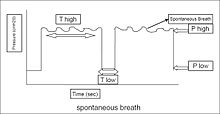Source: Wikipedia, the free encyclopedia.
Average air pressure in assisted ventilation
Mean airway pressure typically refers to the mean pressure applied during
hemodynamic performance, and
barotrauma .
[2] It can also match the alveolar pressure if there is no difference between inspiratory and expiratory resistance.
[3] Equations There are several equations aimed at determining the real mean airway pressure.
Volume control ventilation In ventilation with a square flow waveform this equation can be used:
P
¯
a
w
=
0.5
×
(
P
I
P
−
P
E
E
P
)
×
(
T
I
/
T
t
o
t
)
+
P
E
E
P
{\displaystyle {\bar {P}}_{aw}=0.5\times (PIP-PEEP)\times (T_{I}/T_{tot})+PEEP}
where:
P
¯
a
w
{\displaystyle {\bar {P}}_{aw}}
P
I
P
{\displaystyle PIP}
P
E
E
P
{\displaystyle PEEP}
T
I
{\displaystyle T_{I}}
T
t
o
t
{\displaystyle T_{tot}}
Pressure control ventilation During pressure control ventilation this variant of the equation can be used:
P
¯
a
w
=
(
P
I
P
−
P
E
E
P
)
×
(
T
I
/
T
t
o
t
)
+
P
E
E
P
{\displaystyle {\bar {P}}_{aw}=(PIP-PEEP)\times (T_{I}/T_{tot})+PEEP}
P
¯
a
w
{\displaystyle {\bar {P}}_{aw}}
P
I
P
{\displaystyle PIP}
P
E
E
P
{\displaystyle PEEP}
T
I
{\displaystyle T_{I}}
T
t
o
t
{\displaystyle T_{tot}}
[3] Airway pressure release ventilation Variables of APRV schematic In airway pressure release ventilation (APRV) a variation of the previous equation must be used for the variables:
P
¯
a
w
=
(
P
h
i
g
h
×
T
h
i
g
h
)
+
(
P
l
o
w
×
T
l
o
w
)
T
h
i
g
h
+
T
l
o
w
{\displaystyle {\bar {P}}_{aw}={\frac {(P_{high}\times T_{high})\,+(P_{low}\times T_{low})}{T_{high}+T_{low}}}}
where:
P
¯
a
w
{\displaystyle {\bar {P}}_{aw}}
P
h
i
g
h
{\displaystyle {P}_{high}}
P
l
o
w
{\displaystyle {P}_{low}}
T
h
i
g
h
{\displaystyle {T}_{high}}
P
h
i
g
h
{\displaystyle {P}_{high}}
T
l
o
w
{\displaystyle {T}_{low}}
P
l
o
w
{\displaystyle {P}_{low}}
[4] Other equations
M
P
A
W
=
f
×
T
i
60
×
(
P
I
P
−
P
E
E
P
)
+
P
E
E
P
{\displaystyle M_{PAW}={\frac {f\times T_{i}}{60}}\times (P_{IP}-PEEP)+PEEP}
M
P
A
W
=
F
1
F
1
+
F
E
×
P
I
P
+
(
1
−
F
1
F
1
+
F
E
)
×
P
E
E
P
{\displaystyle M_{PAW}={\frac {F_{1}}{F_{1}+F_{E}}}\times P_{IP}+\left(1-{\frac {F_{1}}{F_{1}+F_{E}}}\right)\times PEEP}
M
P
A
W
=
(
R
)
(
T
i
)
(
P
I
)
+
[
60
−
(
R
)
(
T
i
)
]
(
P
E
E
P
)
60
{\displaystyle M_{PAW}={\frac {(R)(T_{i})(P_{I})+[60-(R)(T_{i})](PEEP)}{60}}}
M
P
A
W
=
f
×
T
i
60
×
(
P
I
P
−
P
E
E
P
)
+
P
E
E
P
{\displaystyle M_{PAW}={\frac {f\times T_{i}}{60}}\times (P_{IP}-PEEP)+PEEP}
[5]
M
P
A
W
=
(
T
i
×
P
I
P
)
+
(
T
e
×
P
E
E
P
)
T
i
+
T
e
{\displaystyle M_{PAW}={\frac {(T_{i}\times P_{IP})+(T_{e}\times PEEP)}{T_{i}+T_{e}}}}
Clinical significance Mean airway pressure has been shown to have a similar correlation as plateau pressure to mortality.[6]
MAP is closely associated with mean alveolar pressure and shows the stresses exerted on the lung parenchyma on mechanical ventilation.[7]
In high frequency oscillatory ventilation , it has been suggested to set the mean airway pressure six above the lower inflection point on the lungs P-V curve.[8]
See also References
. . ^ .
. . Retrieved 30 March 2012 .. . .
Fundamentals Modes Related illness Pressure Volumes
Other
Cdyn
Cstatic
PA O2
VD /VT OI A-a gradient
Mechanical power
















}{60}}}](https://wikimedia.org/api/rest_v1/media/math/render/svg/c386d4e8bc294a8206393853507d118b5ef8f1c9)
